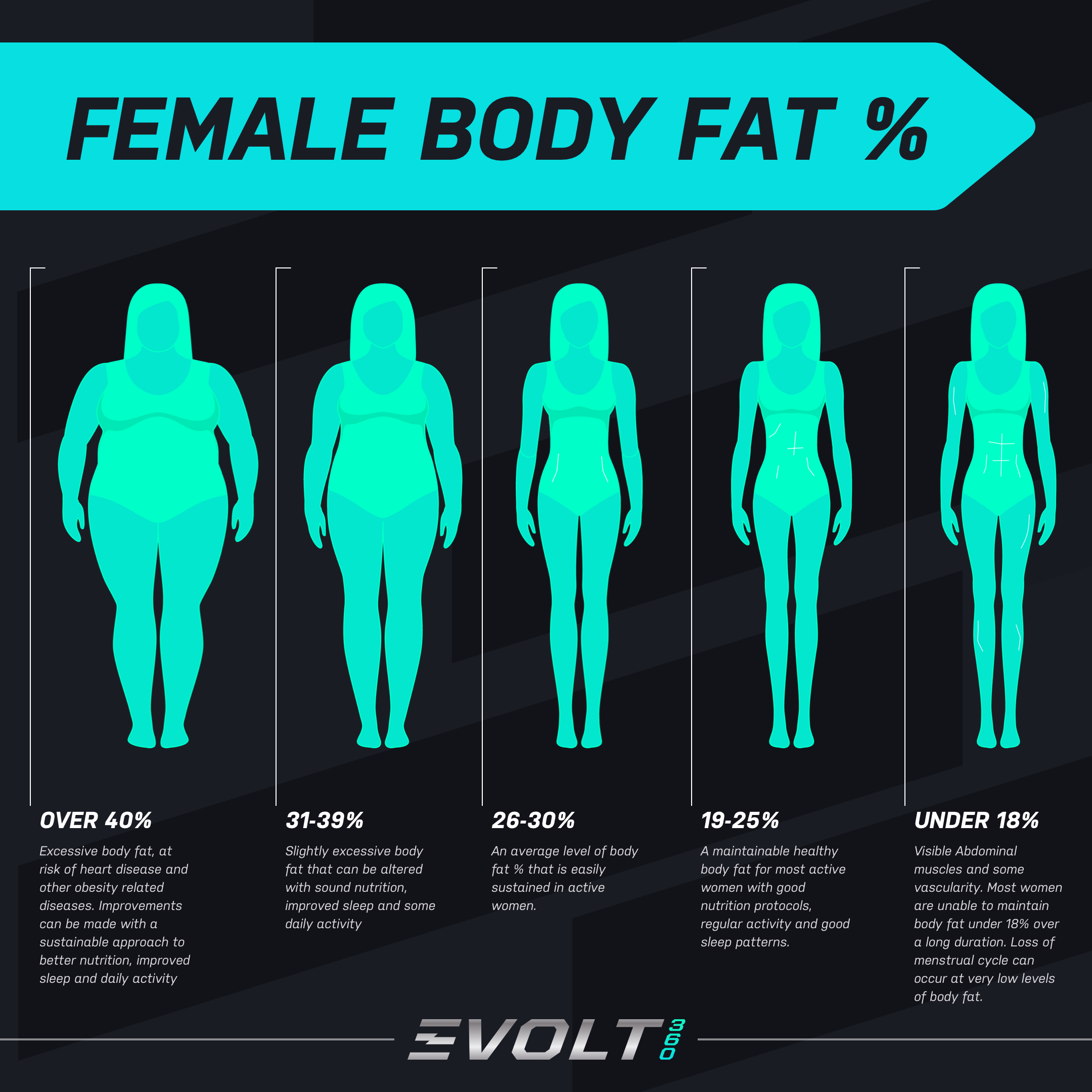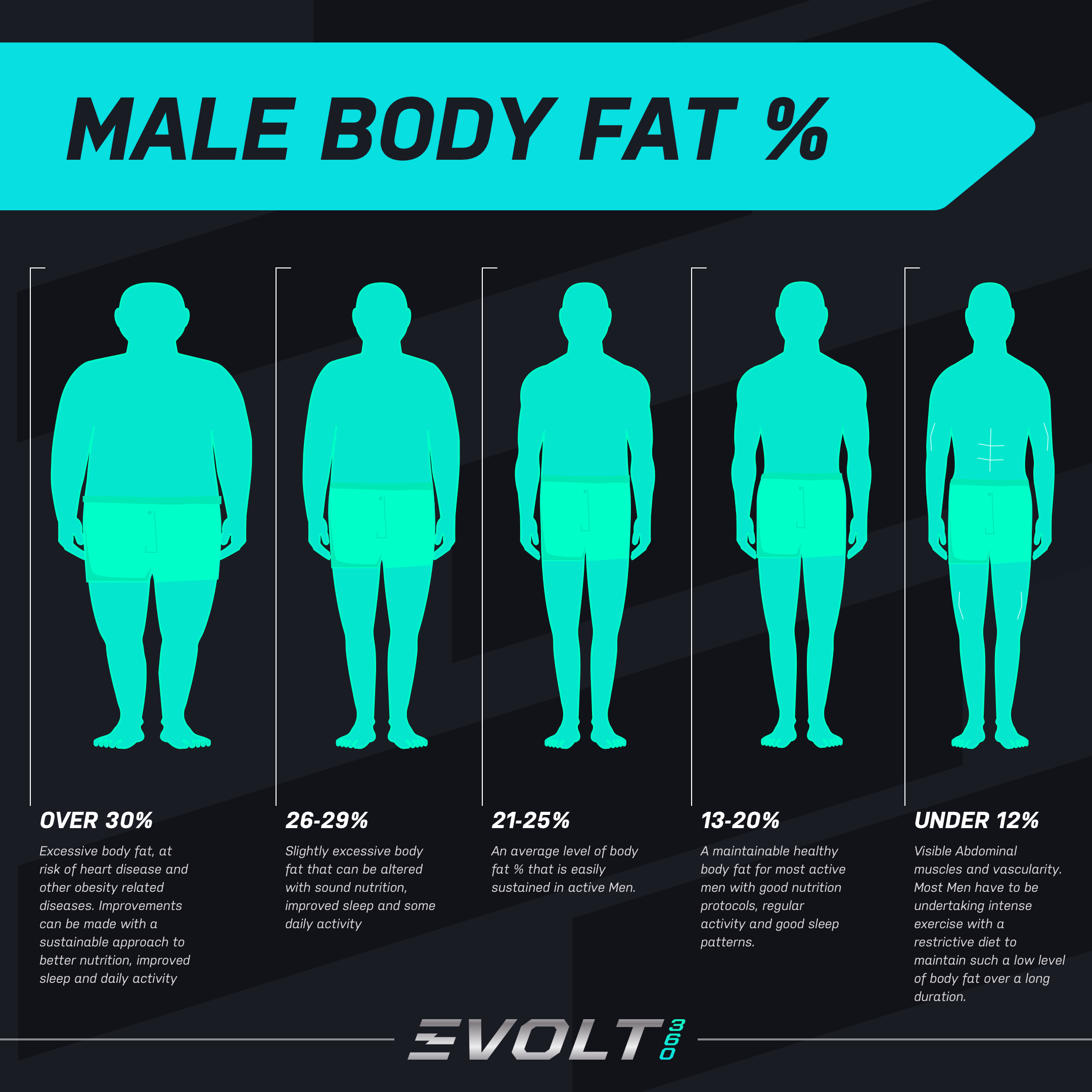Overall body fat percentage is very individual and looks different on any given person but generally, males and females have differing body fat percentages based on their physiology.

So, what factors influence body fat percentage in each gender?
Physiological Gender Differences
Women typically have around 10% higher body fat compared to men but aging increases the risk of obesity in both sexes. The major differences between the genders occur during and after puberty. The increase in body weight in males is primarily due to increases in the lean mass whereas in females it is due to increases in fat mass. Standard android and gynoid fat distribution also present itself for the first-time during puberty.

Menopause can also directly affect body fat percentage in women. Normally at the onset of menopause there will be a redistribution of adipose tissue towards the central part of the body (android fat distribution), this has been related to the drop in serum estrogen levels.
As testosterone declines with age, visceral fat deposition also increases in men.
*Very little is understood about cellular and molecular change due to synthetic sex steroid use, but several studies show clear fat deposition shifts (to the final gender) in transgendered individuals. But again, more research is needed on the affects of synthetic sex hormones and its subsequent affects on growth and metabolism.
Body Fat Percentage
Differences in Fat tissue and Metabolic Function Between Men & Women
Women are effective in storing fat subcutaneously and men viscerally. Women also store a higher percentage of meal derived fatty acids compared to men. At the whole-body level women deposit double the amount of free fatty acid in adipose tissue. One physiological difference worth nothing is the difference in the adipocyte between male and female. Several studies have shown through imaging that female fat accumulation is associated with a higher adipocyte number (cellular hyperplasia) while men have an increased adipocyte size (cellular hypertrophy).
Generally, it is inaccurate to compare body fat percentages from person to person. A more accurate reflection of reduction in subcutaneous fat, is to look at the segmental body fat in kg/lbs for each limb on the scan.
Physiological Sex Differences Quick Guide
1) Body Composition/Structural Differences
a) Major differences in and composition are not seen until puberty
i) At 12-13 years, the ratio of FFM to height begins to plateau in females
ii) In males this ratio of FFM to height can continue until age of 20
iii) Females peak at age 15-16
iv) Males peak at age 18-120
2) Body composition of the sexes begins to difference markedly during puberty
a) Primarily due to endocrine responses (increases in sex hormones respectively)
b) Prior to puberty the anterior pituitary gland does not secrete gonadotropic hormones
i) Follicle Stimulating Hormone
ii) Luteinizing Hormone
3) Testosterone secretion results in:
a) Bone Formation
b) Increased rate of Protein synthesis
4) Distribution of muscle mass is different between the sexes
a) Males have a higher percentage of muscle mass in the upper body compared to females
5) Estrogen
a) Broadening the pelvis, stimulating breast development, increasing fat deposition
b) Increases rate of bone growth
6) With age, men and women both tend to accumulate fat and lose muscle and bone density
a) These changes are associated with decreased physical activity, free testosterone, and estrogen
b) By age 65, muscle mass in humans drop around 25-30% this is mainly attributed to decreases around 20-30% in muscle fiber diameter and around 25% in total muscle fiber number
c) Motor unit remodeling, loss of myelination over time—less synapse activity results in decreases of 33% in twitch force and maximal voluntary contraction.
7) Cardiovascular Differences
a) Stroke Volume
i) Approximately 25% lower in women compared to men
ii) Due to:
(1) Smaller heart size
(2) Smaller left ventricle
(3) Smaller blood volume
b) Heart Rate
i) Generally higher in females
ii) Accommodates for smaller SV
c) Cardiac Output
i) Similar, but met through higher HR and lower SV
ii) Fick Equation for reference 𝑄=𝑣𝑂2𝐶[𝑎−𝑉]𝑂2
iii) Women have less potential for increasing A-VO2 difference
(1) Due to lower Hb content (10% less than men)
(2) Lower arterial O2 content, reduced muscle oxidative potential
(3) Lower Hb is important contributor to lower VO2Max in women
8) Strength
a) Upper Body Strength
i) Women 40-60% lower than males
b) Lower Body Strength
i) Women 25-30% lower than males
c) When comparing muscle difference across cross sectional area:
i) Accounting for body weight and area, lower body strength still 5-15% lower in women
9) Body Composition Take Home:
a) Similar changes in men and women
b) Magnitude of change related to volume and intensity of training, not gender
c) Women may gain less FFM due to hormonal differences (lower free testosterone)
d) When program is followed (and good) there will similar increases in muscle strength comparative to body weight and cross sectional area
e) Men may have more hypertrophy
f) Mechanism of hypertrophy being less is females is unknown, possible theory includes neural drive and lowered synapse activity (see above).
